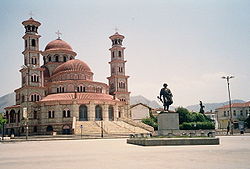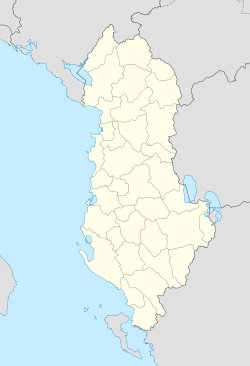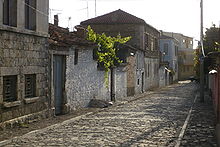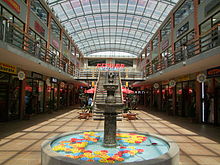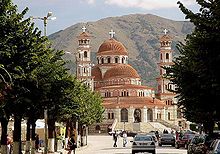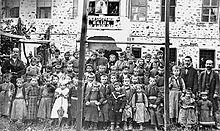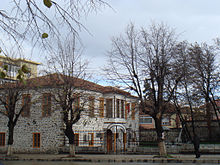- Korçë
-
"Korce" redirects here. For the Polish village, see Korce, Poland.
Korçë — Municipality and City — Centre of Korçë 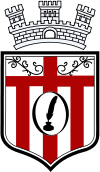
SealMotto: Korça ku dua të jetoj (Korça where I want to live) Coordinates: 40°37′N 20°46′E / 40.617°N 20.767°ECoordinates: 40°37′N 20°46′E / 40.617°N 20.767°E Country Albania County Korçë County District Korçë District Regions (Rajone) 3 Government – Mayor Niko Peleshi (PS) Elevation 850 m (2,800 ft) Population (2009)[1] – Total 79,697 Time zone Central European Time (UTC+1) – Summer (DST) CEST (UTC+2) Postal code 7001-7004 Area code(s) 082 Website www.bashkiakorce.gov.al Korçë (Definite Albanian form: Korça, other names see below) is a city in southeastern Albania and the capital of the Korçë District. It has a population of around 105,000 people (2009 census),[1] making it the sixth largest city in Albania. It stands on a plateau some 850 m (2,789 ft) above sea level, surrounded by the Morava Mountains.
Contents
Name
Korçë is named differently in other languages: Aromanian: Curceaua or Cоrceaо; Bulgarian: Корча, Korcha or Горица, Goritsa (archaic form); Greek: Κορυτσά, Koritsá; Italian: Corizza or Corcia; Macedonian: Горица, Gorica; Turkish: Görice.
History
Antiquity
Neolithic remains have been found indicating occupation of the site from 4000 BC onwards. The Copper Age lasted from 3000 BC to 2100 BC. Mycenean pottery was introduced in the plain of Korçë during the late Bronze Age (Late Helladic IIIc),[2] and has been claimed that the tribes living in this region before the Dark Age migrations, probably spoke a northwestern Greek dialect.[3] The area was on the border between Illyria and Epirus and according to a historical reconstruction was ruled by an Illyrian dynasty until 650 BC, while after 650 BC a Chaonian dynasty.[4][5][6] During this period the area was inhabited by ancient Greek tribes, possibly Chaonians or Molossians, which were two of the major three tribes inhabiting the region of Epirus.[7] Archaeologists have found a gravestone of the 2nd or 3rd century AD depicting two Illyrian blacksmiths working iron on an anvil near modern Korçë.[8]
Middle Ages and Ottoman Rule
A town named 'Coviza' is mentioned in medieval documents in 1280.[citation needed] The modern town dates from the end of the 15th Century, when Iljaz Hoxha, under the command of Sultan Mehmet II, developed Korçë.[9] The Ottoman occupation began in 1440, and after Hoxha's role in the siege of Constantinople, in 1453; he was awarded the title, 'Iljaz Bey Mirahor'. Korçë was a sandjak of the Manastir vilayet in the Ottoman Empire as Görice.[10] The city started to flourish when the nearby town of Moscopole was raided by the Muslim Albanian troops of Ali Pasha at 1788.[11] [12]
20th century
Early 20th century
Ottoman rule over Korçë lasted until 1912; although the city and its surroundings were supposed to become part of the Principality of Bulgaria according to the Treaty of San Stefano in 1878, the Treaty of Berlin of the same year returned the area to Ottoman rule.[13] Korçë's proximity to Greece, which claimed the entire Orthodox population as Greek, led to its being fiercely contested in the Balkan Wars of 1912-1913. Greek forces captured Korçë from the Ottomans in 6 December 1912 and afterwards proceeded to imprison the Albanian nationalists of the town.[14] Its incorporation into Albania in 1913 was disputed by Greece, who claimed it as part of a region called 'Northern Epirus', and resulted in a rebellion by the local Greek population that asked the intervention of the Greek army.[15] This rebellion was initially suppressed by the Dutch commanders of the Albanian gendarmerie, that consisted of 100 Albanians led by Themistokli Gërmenji, as a result the local Greek-Orthodox bishop Germanos and other members of the town council were arrested and expelled by the Dutch.[16][17] However, under the terms of the Protocol of Corfu (May 1914), the city became part of the Autonomous Republic of Northern Epirus inside the borders of the principality of Albania,[18] while in 10 July 1914 the Greek Northern Epirote forces took over the city.[19]
In October 1914 the city came again under Greek administration. During the period of the National Schism (1916) a local revolt broke out and with military and local support Korçë came under the control of Eleftherios Venizelos' Movement of National Defence, overthrowing the royalist forces.[20] However, due to developments in the Macedonian Front of World War I the city came soon under French control (1916–1920). During this time fourteen representatives of Korçë and Colonel Descoins signed a protocol that proclaimed the Autonomous Albanian Republic of Korçë (Albanian: Republika Shqipëtare Korçë under the military protection of the French army and with Themistokli Gërmenji as president.[16][21] It ultimately remained part of Albania, as determined by the International Boundary Commission, which affirmed the country's 1913 borders.
During the inter-war period, the city became a hotbed of Communist agitation. Albania's future dictator, Enver Hoxha, lived there and was both a pupil and a teacher at the town's French school. Korçë's underground Communist movement became the nucleus of Hoxha's Albanian Party of Labour. During the 1930s, the Bank of Athens had a branch in the city.
World War II
Italian forces occupied Korçë in 1939, along with the rest of the country. After the outbreak of the Greco-Italian War, the Greek Army entered the city in November 1940, which remained under Greek sovereignty until the German attack in April 1941. After Italy's withdrawal from the war in 1943, the Germans occupied the town until October 24, 1944.
During the occupation, the city became a major center of Communist-inspired resistance to the Axis occupation of Albania. The establishment of the Albanian Party of Labour – the Communist Party – was formally proclaimed in Korçë in 1941. Albanian rule was restored in 1944 following the withdrawal of German forces.
Socialist era
The area suffered from Hoxha's dictatorial regime like the rest of Albania, although it is arguable whether it was to as great an extent. Hoxha mainly fought against the rich, despite the fact that they had often fought against the Nazi and Fascist occupations. Right after World War II many people fled to Boston, USA, joining a community of the Albanian-Americans, who had previously emigrated there.
After 1990 Korçë was one of the six cities where the New Democratic Party won all the constituencies. Popular revolts in February 1991 ended with the tearing down of Hoxha's statue.
Climate
Korçë has a transitional mediterranean climate (or continental mediterranean climate) with high temperature amplitudes. The hottest month is August (25 °C (77 °F)) while January (2 °C (36 °F)) is the coldest. The city receives around 650 millimeters (26 in) annual precipitation with summer minimum and winter maximum. The temperatures in Korçë generally remain cooler than the western part of Albania, due to the middle altitude of the plain in which it is situated, but it receives about 2300 hours of solar radiation per year, so its temperatures are higher than those in Northeastern Albania. Temperatures can still reach up to 40 °C (104 °F) or higher on occasions.
Religion
Korçë has been an important religious center for Orthodox Christians for centuries. It has a large Orthodox community and it is the seat of an Orthodox metropolitan bishop. There is also a large Sunni community in and around the city. Islam entered the city in the 15th century through Iljaz Hoxha, a famous Albanian jannissary, who actively participated in the Fall of Constantinople.[9] One of the oldest mosques was built in Albania by Iljaz Hoxha in 1484, the Ilias Mirahori Mosque.[22] Also a Bektashi community is present in the city. The main center of the Bektashis of the area is the Turan Tekke.
Museums
Korçë is called the city of museums. The National Museum of Medieval Art of Albania, has a rich archives of ca. 6500 icons and 500 other objects in textile, stone and metal. The National Museum of Archeology is located in Korçë. The first Albanian School as well as the house of the painter Vangjush Mio and his gallery function as museums. Another museum in Korçë is the Bratko Museum and the Oriental Museum.
Education
The first school, a Greek language school, in the city was established in 1724.[23] This school was destroyed during the Greek War of Independence but it reopened at 1830. In 1857 a female Greek language school was operating in the city.[24] During the 19th century various local benefactors such as Ioannis Pangas donated money for the promotion of Greek education and culture in Korçë.[25][26] A special community fund, named the Lasson fund, was established in 1850 by the local Orthodox bishop Neophytos [27] in order to support Greek cultural activity.[28] The city also hosted a Romanian school at that time.[citation needed]
In the end of 19th century local Albanians expressed a growing need to be educated in their native language.[29] The first Albanian language school was established in 1887 by the Drita (English: Light) organization and funded by notable local individuals. Its first director was Pandeli Sotiri.[30] Naim Frashëri, the national poet of Albania played a great role in the opening of the school in 1887. As a high-ranking statesman in the ministry of education of the Ottoman Empire he managed to get official permission for the school. The Ottoman authorities gave permission only for Christian children to be educated in Albanian, but the Albanians did not follow this restriction and allowed also Muslim children to attend. As a result the school was closed in 1902 by the Ottoman authorities.[31]
The school was followed by Albania's first school for girls in 1891. The school, started by Gjerasim Qiriazi was later run by his sisters, Sevasti and Parashqevi Qiriazi together with Polikseni Luarasi (Dhespoti). Later collaborators were the Rev. & Mrs. Grigor Çilka and Rev & Mrs. Phineas Kennedy of the Congregational Misson Board of Boston.
When the city was under French administration in 1916 (the Republic of Korçë), Greek schools were closed and 200 Albanian and French language schools were opened. A few months later Greek schools were reopened as a reward and result of Greece's adhesion to the Entente alliance, part of which was France, although the decision to reopen them was in contradiction with the wishes of the population.[32] Particularly relevant was the opening in 1917 of the Albanian National Lyceum.
The city is home to Fan Noli University, founded in 1971, which offers several degrees in humanities, business, and sciences. The University includes a school in Agriculture, Teaching, Business, Nursing, and Tourism.
In April 2005 the first bilingual Greek-Albanian school opened in Korçë after 60 years of prohibition of Greek education in the city.[33] In addition, a total of 12 Greek language institutes are functioning in the city.[34]
Economy
During the 20th century, Korçë gained a substantial industrial capacity in addition to its historic role as a commercial and agricultural centre. The plateau on which the city stands is highly fertile and is one of Albania's main wheat-growing areas. Local industries include the manufacture of knitwear, rugs, textiles, flour-milling, brewing, and sugar-refining. Deposits of lignite coal are mined in the mountains nearby such as Mborje-Drenovë. The city is home to the nationally famous Birra Korça.
Sport
- The football (soccer) club is KS Skënderbeu Korçë, Albanian Champions in 1933 and recently, in 2011.
Panorama
Notable people from Korçë
In alphabetical order by last name:
- Thoma Abrami, poet and activist of the Albanian National Awakening
- Servet Tefik Agai soccer player, leading goalscorer of the fourth Championship of the Albanian Superliga.
- Anthony Athanas, multi-millionaire restauranteur and philanthropist.
- Anastas Avramidhi-Lakçe (1821–1890) businessman and benefactor.
- Dhimitër Berati, signatory of the Albanian Declaration of Independence.
- Pandeli Cale, rilindas and signatory of the Albanian Declaration of Independence
- Kristo Dako, minister of education and political activist
- Visar Dodani, journalist and activist of the Albanian National Awakening.
- Pandeli Evangjeli, twice Prime Minister of Albania
- Pavlina Evro, mid-distance runner, winner of the in the 1500 meter race at the "Grand Prix" International Athletic Meeting in Nice (France)
- Eli Fara, singer.
- Thanas Floqi, rilindas and signatory of the Albanian Declaration of Independence
- Llazar Fundo, member of the Albanian Communist Party during WWII.
- Pandi Gëllçi, notable volleyball coach of Skenderbeu volleyball team.
- Mihal Grameno, rilindas, freedom fighter along Çerçiz Topulli, journalist, and writer.
- Spiro Ilo, signatory of the Albanian Declaration of Independence
- Idhomene Kosturi, former Prime Minister of Albania
- Kostaq Kota, politician
- Panteleimon Kotokos (1890–1969), Greek Orthodox bishop of Gjirokastër (1937–1941).
- Koçi Bey 17th century high-ranking Ottoman bureaucrat
- Ermal Kuqo, basketball player, member of the Albanian national basketball team.
- Savva Lika, javelin thrower.
- Sabien Lilaj, Albanian footballer
- Devis Mema, Albanian footballer, capped with Albania U-21
- Jani Melka[35] Albania National Team volleyball player, also known in Greece, where he plays with Aris Thessaloniki, as Giannis Melkas[36][37]
- Gjon Mili, fotographer
- Vangjush Mio, painter.
- Thimi Mitko, nationalist and folklorist.
- Dhimitër Orgocka actor and screenplayer, People's Artist of Albania
- Thoma Orollogaj, minister of justice of Albania and Balli Kombëtar leader.
- Tefik Osmani, football soccer player, capped with the Albania
- Ioannis Pangas (1814–1895), Greek entrepreneur and benefactor.
- Pilo Peristeri, former member of the Politburo of the Party of Labour of Albania and former Minister in the Albanian Government
- Alma Qeramixhi, 1992 Olympic Games participant, heptathlete and 100 hurdles record keeper for Albania.
- Leonidas Sabanis, weightlifter Olympic Games Silver Medal winner for Greece
- Aristotel Samsuri, soccer player, leading goalscorer of the second Championship of the Albanian Superliga.
- Llazi Sërbo, film and stage actor.
- Behar Shtylla, diplomat and Foreign Minister of Albania from 1953 to 1970
- Konstantinos Skenderis, Greek author and politician.
- Stavro Skëndi, historian and linguist
- Misto Treska, diplomat, translator and writer
- Kristi Vangjeli football soccer player, capped with the Albania
- Dhimitër Zografi, signatory of Albanian Declaration of Independence
International relations
Twin towns — Sister cities
See also: List of twin towns and sister cities in AlbaniaKorçë is twinned with:
 Thessaloniki, Greece[38]
Thessaloniki, Greece[38] Cluj-Napoca, Romania[39]
Cluj-Napoca, Romania[39] Mitrovica, Kosovo[39]
Mitrovica, Kosovo[39] Verona, Italy[39]
Verona, Italy[39] Los Alcázares, Spain[39]
Los Alcázares, Spain[39]
See also
- Autonomous Albanian Republic of Korçë
- Autonomous Republic of Northern Epirus
- Greeks in Albania
- Tourism in Albania
- Kamenica Tumulus
- Moscopole
- Dardhë
- Liqenas
- Albanian diaspora
- Music of Albania
- List of castles in Albania
- Devoll District
- Northern Epirus
Sources
- Municipality of Korçë
- N.G.L Hammond, Alexander's Campaign in Illyria, The Journal of Hellenic Studies, pp 4–25. 1974
- James Pettifer, Albania & Kosovo, A & C Black, London (2001, ISBN 0713650168)
- François Pouqueville, Voyage en Morée, à Constantinople, an Albanie, et dans plusieurs autres parties de l'Empire othoman, pendant les années 1798, 1799, 1800 et 1801. (1805)
- T.J. Winnifrith Badlands-Borderlands A History of Northern Epirus/Southern Albania (2003)
References
- ^ a b Instat of Albania (2009). "Population by towns" (in Albanian). Institute of Statistics of Albania. http://www.instat.gov.al/graphics/doc/tabelat/Treguesit%20Sociale/Popullsia/POP%202009/t4%20.xls. Retrieved 19 August 2010.
- ^ Carol Zerner, Peter Zerner, John Winder, John Winder. Wace and Blegen: pottery as evidence for trade in the Aegean Bronze age, 1939-1989. J.C. Gieben, 1993, ISBN 9789050630894, p. 222
- ^ Hammond Nicholas Geoffrey Lemprière. Migrations and invasions in Greece and adjacent areas. Noyes Press, 1976, p. 153.
- ^ Wilkes, J. J. The Illyrians, 1992, ISBN 0631198075, page 47, "According to one reconstruction (Hammond) we have the evidence of an Illyrian dynasty being replaced by a Chaonian regime from Northern Epirus"
- ^ The Cambridge ancient history: The expansion of the ..., Tome 3, Part 3, bt John Boardman,Nicholas Geoffrey Lemprière Hammond, page 263, "In the plain of Korçë Illyrian rule ended c. 650 BC, when the burials of "
- ^ The Cambridge ancient history, Tome 3, Part 3, by John Bagnell Bury, "In the plain of Korçë Illyrian rule ended c. 650 BC, when the burials of their chieftains in Tumulus I at Kuci Zi came to an end"
- ^ John Boardman. The Cambridge Ancient History: pt. 1. The prehistory of the Balkans; and the Middle East and the Aegean world, tenth to eighth centuries B.C. Cambridge University Press, p. 266: "We may conclude, then, that the archaeological division corresponded to a tribal division : the Illyrian tribes holding northern Illyris, and the Epirotic tribes, whether Chaonian or Molossian, holding the plain of Korçë"
- ^ Stipčević, Aleksandar (1977). The Illyrians: history and culture. Noyes Press. p. 223. ISBN 9780815550525. http://books.google.com/books?ct=result&id=NLcWAQAAIAAJ&dq=Illyrians+%2B+Korçë&q=Gravestone+from+near+Korçë+in+Albania,+showing+two+Illyrian+blacksmiths+working+iron+on+an+anvil.+Second+or+third+century+ad#search_anchor. Retrieved 18 October 2010.
- ^ a b "Iljaz Bej Mirahori". http://www.bashkiakorce.gov.al/frontend/article.php?aid=140&cid=51. Retrieved 2010-03-25.
- ^ Masud, Muhammad (2006). Dispensing justice in Islam: Qadis and their judgements. BRILL. pp. 283. ISBN 9004140670. http://books.google.com/books?id=yvjcpJ_8E9oC&pg=PA283&dq=Görice.
- ^ Princeton University. Dept. of Near Eastern Studies. Princeton papers: interdisciplinary journal of Middle Eastern studies. Markus Wiener Publishers, 2002. ISSN 1084-5666, p. 100.
- ^ Fleming Katherine Elizabeth. The Muslim Bonaparte: diplomacy and orientalism in Ali Pasha's Greece. Princeton University Press, 1999. ISBN 9780691001944, p. 36: "...destroyed by Muslim Albanian troops"
- ^ "History of Albania, 1878-1912". World History at KMLA. http://www.zum.de/whkmla/region/balkans/albania18781912.html. Retrieved 2008-10-08.
- ^ Pearson, Owen (2004). Albania and King Zog: independence, republic and monarchy 1908-1939. Albania in the twentieth century. 1. I. B. Tauris. pp. 35. ISBN 1845110137.
- ^ Roudometof, Victor (2002). Collective memory, national identity, and ethnic conflict: Greece, Bulgaria, and the Macedonian question. Greenwood Publishing Group. pp. 155. ISBN 0275976483. http://books.google.com/books?id=Xoww453NVQMC&pg=PA155&dq=greek+army+korce&cd=9#v=onepage&q=greek%20army%20korce&f=false.
- ^ a b Pearson, Owen (2004). Albania and King Zog: independence, republic and monarchy 1908-1939. I.B.Tauris. p. 103. ISBN 9781845110130. http://books.google.com/books?id=3_Sh3y9IMZAC&pg=PA103&dq=Themistokli+Germenji#v=onepage&q=led%20by%20Themistokli%20Germenji&f=false. Retrieved 4 November 2010.
- ^ Kondis Basil. Greece and Albania, 1908-1914. Institute for Balkan Studies, 1976, p. 130: "The Dutch, having proof that Metropolitan Germanos was chuef instigator of the rising, arrested him and other members of the town council and sent them to Elbasan."
- ^ Valeria Heuberger, Arnold Suppan, Elisabeth Vyslonzil (1996) (in German). Brennpunkt Osteuropa: Minderheiten im Kreuzfeuer des Nationalismus. Oldenbourg Wissenschaftsverlag. p. 69. ISBN 9783486561821. http://books.google.com/books?id=edAu3dxEwwgC.
- ^ The Ottoman Empire and Its Successors, 1801-1927. William Miller, 1966. ISBN 0714619744
- ^ Kondis Basil. The Greeks of Northern Epirus and Greek-Albanian relations. Hestia, 1995, p. 32: ""a rebellion broke out in Korytsa... their loyalty to the National Defence movement."
- ^ Schmidt-Neke, Michael (1987). Enstehung und Ausbau der Königsdiktatur in Albanien, 1912-1939. Oldenbourg Wissenschaftsverlag. p. 43. ISBN 9783486543216. http://books.google.com/books?id=vpIFsca3lKYC&pg=PA43&dq=Themistokli+Germenji#v=onepage&q=Themistokli%20Germenji&f=false. Retrieved 8 November 2010.
- ^ Petersen, Andrew (1994). Dictionary of Islamic architecture. Routledge. p. 10. ISBN 0415060842. http://books.google.com/books?id=t5gOAAAAQAAJ&pg=PA10&dq=City+of+Stone+gjirokaster#v=onepage&q=City%20of%20Stone%20gjirokaster&f=false. Retrieved 2010-06-13.
- ^ Basil Kondis. The Greeks of Northern Epirus and Greek-Albanian relations. Hestia, 1995, p. 9: ""The first school of the Hellenic type in Korytsa opened in 1724"
- ^ Sakellariou M. V., Epirus, 4000 years of Greek history and civilization. Ekdotikē Athēnōn, 1997, ISBN 9789602133712, p. 308
- ^ Basil Kondis. The Greeks of Northern Epirus and Greek-Albanian relations. Hestia, 1995, p. 9 "With the money bequeathed by An. Avramidis two schools of the Hellenic type, a girls' school, and three primary schools were founded"
- ^ Ismyrliadou, Adela; Karathanasis, Athanasios (1999). "Koritsa: Education-Benefactors-Economy 1850-1908". Balkan studies: biannual publication of the Institute for Balkan Studies 1 (40): 224–228. http://books.google.com/books?id=6VVpAAAAMAAJ&q=Lasso%2Bkoritsa&dq=Lasso%2Bkoritsa&cd=1. "Among them benefactors Ioanis Bangas (1814-1895) and Anastasios Avramidis Liaktsis have a definite place...", "General Rules for Public Institutions in the town of Koritsa were drawn up and changed for the better the functioning of the educational estamblishments."
- ^ Ismyrliadou, Adela (1996). "Educational and Economic Activities in the Greek Community of Koritsa during the Second Half of the Nineteenth Century". Balkan studies: biannual publication of the Institute for Balkan Studies 1 (37): 235–255. http://books.google.com/books?ei=XVWfTquCE4rEsgbcmrX-Ag&ct=result&hl=el&id=XVRpAAAAMAAJ&dq=Community+Fund+by+the+Metropolitan+of+Koritsa%2C+Neofytos&q=lasso+hostels#search_anchor.
- ^ Sakellariou, M. V. (1997). Epirus, 4000 years of Greek history and civilization. Ekdotike Athenon. pp. 255. ISBN 9789602133712. http://books.google.gr/books?id=UV1oAAAAMAAJ&q=%22In+the+Regulations+the+harmonious+and+honest+management+of+this+fund+is+presented+as+a+basic+duty+of+the+community.+The+lasso+was+established+for+%22the+upkeep+of+the+common+Schools+in+the+city+for+the+dissemination+of+Greek+Letters+and+enlightenment%22&dq=%22In+the+Regulations+the+harmonious+and+honest+management+of+this+fund+is+presented+as+a+basic+duty+of+the+community.+The+lasso+was+established+for+%22the+upkeep+of+the+common+Schools+in+the+city+for+the+dissemination+of+Greek+Letters+and+enlightenment%22&hl=el&ei=uFmfTur1BuKL4gTX7MX9BA&sa=X&oi=book_result&ct=result&resnum=1&ved=0CCoQ6AEwAA.
- ^ The question of the education of the Albanians in their own language was a problem posed many times in the reports of American religious missionaries in the Balkans. In June 1896 Reverend Lewis Bond reported that lessons at the Korça (Korcë) school were conducted in modern Greek, while the local people loved their own tongue which they spoke only at their homes. "Can we do anything for them", asked Reverend Bond. His question obviously remained rhetorical, because three years later he sent another, much more extensive, statement on the issues of the language and education of the Albanians in Korçë. He wrote that only at the girls' school, set up by the Protestant community, the training was in Albanian and once more claimed there was no American who would not sympathise with the Albanians and their desire to use their own language Source : Antonina Zhelyazkova Albanian identities . International center for minority study and intercultural relations. Sofia .BULGARIA 1999
- ^ Clayer, Natalie (2007) (in French). Aux origines du nationalisme albanais: la naissance d'une nation majoritairement musulmane en Europe. KARTHALA Editions. pp. 301–10. ISBN 2845868162. http://books.google.com/books?id=umotBF3KFWgC&pg=PA309&dq=Avramidhi&cd=1#v=onepage&q=Avramidhi&f=false.
- ^ Özdalga, Elisabeth (2005). SOAS/Routledge Curzon studies on the Middle East. 3. Routledge. pp. 264â5. ISBN 0415341647. http://books.google.com/books?id=sRtTyyGIgXsC&pg=PA264&dq=korce+albanians&cd=11#v=onepage&q=korce%20albanians&f=false.
- ^ Stickney, Edith Pierpont (1924). Southern Albania, 1912-1923. pp. 69–70. http://books.google.com/books?id=n4ymAAAAIAAJ&q=Northern+Epirus#v=onepage&q=%22several%20months%20later%2C%20Greek%20schools%20were%20reopened%20as%20a%20result%20of%20Greek%20influence%22&f=false. "several months later, Greek schools were reopened as a result of Greek influence"
- ^ "Albanische Hefte. Parlamentswahlen 2005 in Albanien" (in German). Deutsch-Albanischen Freundschaftsgesellschaft e.V.. 2005. pp. 32. http://www.albanien-dafg.de/downloads/AH-3-2005.pdf.
- ^ Σοφία Βούρη, Γεώργιος Καψάλης.Ελληνόγλωσση εκπαίδευση στην Αλβανία. Ε.ΔΙΑ.Μ.ΜΕ., Ρέθυμνο 2003
- ^ "Storia della Pallavolo Albanese(English: History of the Albanian Volleyball)". Albanianews. http://www.albanianews.it/sport/item/1184-storia-pallavolo-albanese-1.
- ^ Sport.gr
- ^ Ethnos.net
- ^ "Twinning Cities". City of Thessaloniki. http://www.thessalonikicity.gr/English/twinning-cities.htm. Retrieved 2009-07-07.
- ^ a b c d Korçë Municipality. "Twin cities" (in Albanian). Korçë Municipality. http://www.bashkiakorce.gov.al/frontend/articles.php?cid=64. Retrieved 30 July 2010.
External links
- Korçë County Official Tourist Guide
- Korca at In Your Pocket City Guide
- Korçë at Wikitravel
- Beer Fest
- Kolonja District Tourist Guide
- Municipality of Korçë
Municipalities of Korçë County Capital: KorçëDevoll District 
Kolonjë District Korçë District Pogradec District Cities in Albania Bajram Curri · Bajzë · Ballsh · Berat · Bilisht · Bulqizë · Burrel · Cërrik · Çorovodë · Delvinë · Divjakë · Durrës · Elbasan · Ersekë · Fier · Fushë-Arrëz · Fushë-Krujë · Gjirokastër · Gramsh · Himarë · Kamëz · Kavajë · Këlcyrë · Klos · Konispol · Koplik · Korçë · Krastë · Krrabë · Krujë · Krumë · Kuçovë · Kukës · Kurbnesh · Laç · Leskovik · Lezhë · Libohovë · Librazhd · Lushnjë · Maliq · Mamurras · Manëz · Memaliaj · Orikum · Patos · Peqin · Përmet · Peshkopi · Pogradec · Poliçan · Prrenjas · Pukë · Reps · Roskovec · Rrëshen · Rrogozhinë · Rubik · Sarandë · Selenicë · Shëngjin · Shijak · Shkodër · Sukth · Tepelenë · Tirana · Ulëz · Urë Vajgurore · Vau i Dejës · Vlorë · Vorë

Korçë Landmarks Monument of the National Fighter · Themistokli Gërmenji Monument · Monument to Atentatori Kristaq Rama · Naim Frasheri Monument · Partizani Monument · Mihal Grameno Monument · Naum Veqilharxhi Monument · Mësentorja e Parë Shqipe Obelisk · French Military Cemetery · Elbasan Inn · Old Bazaar of Korçë · Iljaz Mirahori Mosque · Bratko Museum · Vangjush Mio's House Museum · Resurrection Cathedral · Kamenica Tumulus · Oriental Art Museum · National Archaeological Museum of Korçë · National Museum of Medieval Art · Heroes CemeteryEducation Fan Noli University · Albanian National Lyceum · Raqi Qirinxhi High SchoolArchaeological sites Kamenica TumulusPlains Korçë PlainTransport Korçë Northwest AirportMedia Gazeta KorçaNorthern Epirus & Greeks in Albania History Ancient Epirus (Chaones • Dassaretae) • Despotate of Epirus • Revolt of 1854 • Revolt of 1878 • Himara revolt of 1912 • Autonomous Republic of Northern Epirus • Protocol of Corfu • Battle of Morava-Ivan • Northern Epirus Liberation FrontSociety and Culture Greeks in Albania • New Academy • Zographeion College • Himariote dialect • Laiko Vima • Polyphonic song of Epirus • Postage stamps and postal history of Northern EpirusSettlements Ancient: Phoenice • Vouthroton • Apollonia • Thronium • Amantia • Antigonia • Antipatreia • Dimale • Oricum
Modern: Gjirokastër • Korçë • Himarë • Delvinë • Sarandë • Dropull • Pogon • Tepelenë • Permet • Leskovik • Ersekë • Moscopole • Bilisht
Other1: Nartë • Vlorë • Berat • Tirana • Elbasan • Durrës • Fier • ShkodërOrganizations Omonoia • Panepirotic Federation of America • Panepirotic Federation of Australia • Unity for Human Rights PartyIndividuals Benefactors: Alexandros Vasileiou • Apostolos Arsakis • Evangelos and Konstantinos Zappas • Ioannis Pangas • Georgios and Simon Sinas • Alexandros and Michael Vasileiou • Christakis Zografos • Literature: Theodore Kavalliotis • Katina Papa • Konstantinos Skenderis • Takis Tsiakos • Tasos Vidouris • Stavrianos Vistiaris • Andreas Zarbalas • Politics: Vasil Bollano • Georgios Christakis-Zografos • Vangjel Dule • Spiro Ksera • Military/Resistance: Kyriakoulis Argyrokastritis • Panos Bitsilis • Dimitrios Doulis • Konstantinos Lagoumitzis • Zachos Milios • Athanasios Pipis • Ioannis Poutetsis • Vasilios Sahinis • Spyromilios • Spyros Spyromilios • Sports: Pyrros Dimas • Sotiris Ninis • Panajot Pano • Leonidas Sabanis • Andreas Tatos • Clergy: Vasileios of Dryinoupolis • Panteleimon Kotokos Eulogios Kourilas
1 Cities and towns in Albania with Greek-speaking communities, outside the political definition of 'Northern Epirus'.
Wikimedia Foundation. 2010.

